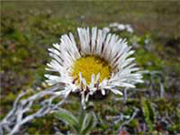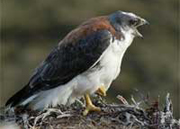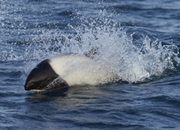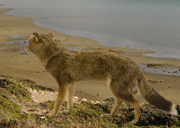THE NATURAL ENVIRONMENT
The natural environment in the Falklands is spectacular with generally tame birds, particularly penguins and marine mammals giving unparalleled opportunities to observe and photograph wildlife. The South Atlantic's deep waters are rich in marine life and this gives life to a diversity of wildlife, from sea-birds to whales. Biogeographically the Falklands are classified as Antarctic ecozone and Antarctic Floristic Kingdom. The flora and fauna of the Falklands has similarities with that of neighbouring Patagonia in South America. The land generally speaking is made up of low grasses, ferns and shrubs, treeless apart from isolated stands of or individual introduced trees. The environment includes amazing 'stone runs', their vastness best appreciated from the air. The two main islands of the Falklands, East and West, provide miles of empty treeless space, undeveloped and sparsely populated by humans. Deeply indented coasts range from steep cliffs to white sandy beaches and sheltered creeks.
 Marine Environment Marine Environment
|
 Falklands Flora Falklands Flora
|
 Birdlife Birdlife
|
 Marine Life Marine Life
|
 Invertebrates Invertebrates
|
 Introduced Mammals Introduced Mammals
|
 Warrah Warrah
|
 Freshwater Life Freshwater Life
|
|
|
Birds and flowers have adapted and found their niches where they can best survive in an unpolluted if windy and wild natural environment. As the bulk of Falkland’s wildlife relies on a maritime environment the smaller satellite islands off the main East and West islands surely have the greatest concentrations of wild birds, including penguins, albatross and seals. Many islands too have still got tussac grass cover although the previous fringe of most Falklands coasts before the arrival of man and livestock has mostly disappeared.
The Falklands have 363 recorded species of vasciular flora. 171 are believed to be native and 13 are endemic to the islands.
There are 21 resident land birds, 18 resident water birds, 22 breeding seabirds, 18 annual non-breeding migrants and 143 species recorded as occasional visitors. (Woods) Over 60% of the world's Black-browed albatross population breed on the Falklands. All bird species apart from Upland Geese and feral domestic geese are protected in the Falkland Islands. Elephant seals, Southern Sea Lions and South American Fur seals breed on the islands. There are six species of freshwater fish. The krill rich seas around the Falklands support 14 species of marine mammal. The only terrestrial mammal, a type of fox, the warrah, was hunted to extinction, the last being killed in 1876.
Sources include: Falkland Islands State of the Environment Report 2008 Otley H, Munro G, Clausen A, Ingham B. A Field Guide to the Wildlife of The Falkland Islands and South Georgia - Ian J Strange, Guide to Birds of the Falkland Islands- Robin W. Woods.
Photographic credits: Header Loggers, Hairy Daisy, Red-backed hawk Robert Maddocks, Commersons Dolphin- Jeremy Richards/Shutterstock.com, fox-Dilys & Alan Waton, Butterfly Marlane Marsh, Warrah Hurst
Photographs and Images Copyright: The images on this site have been bought under licence or have been used with the permission of their owners. They may not be copied or downloaded in any form without their owner's consent. |
     |
|

